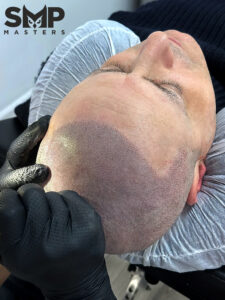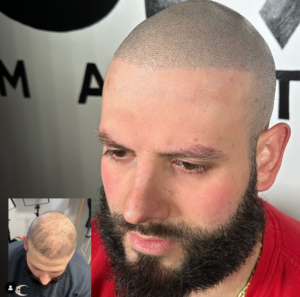Tropophobia managing tropophobia of hair transplant. Most people present with an intense fear or aversion to seeing patterns or clusters of small holes or bumps, commonly referred to as tropophobia. This is, of course, an utterly frightening notion, especially in the context of contemplating or undergoing hair transplantation, as this method involves making very many small incisions on the scalp. The following article provides constructive advice on the management of hair transplant tropophobia, to make the anxiety of the procedure less and the journey toward hair restoration as comfortable as possible.
How To Deal With Hair Transplant Tropophobia
In the realm of cosmetic procedures, hair restoration through transplant has become a beacon of hope for many. However, the journey is not devoid of psychological hurdles, one of which is hair transplant tropophobia. This article delves into understanding this fear, identifying triggers, recognizing symptoms, and provides strategies to manage it, all while weaving through the landscape of scalp micropigmentation services across various locales like USA, New Jersey, and Long Island.
What is Hair Transplant Tropophobia?
Hair transplant tropophobia is an intense fear related to the process of hair transplantation. It often manifests as a deep-seated anxiety that can deter individuals from pursuing or completing hair transplant procedures. This phobia is not just about the fear of surgery but extends to the distress over the change in appearance and the anticipation of the outcome.
What Triggers Tropophobia
-
The triggers for trypophobia can vary widely among individuals. Commonly, it stems from a fear of needles, the sight of blood, or the medical setting in general. For others, the anxiety could be linked to a fear of not achieving the desired results, which could exacerbate existing insecurities about one's appearance.
How to Know if You Have Tropophobia
-
Recognizing trypophobia involves a careful reflection on your emotional reactions to the thought or the process of a hair transplant. Symptoms might include excessive sweating, palpitations, or a feeling of dread when thinking about hair transplant procedures. If these feelings intensify near your appointment or consultation, it might be indicative of trypophobia.
Managing Hair Transplant Tropophobia: Tips and Tricks
Education and Communication
Understanding the procedure thoroughly can alleviate undue stress. Engage in open discussions with your specialist at a renowned clinic such as the best SMP clinic in NJ or a top-tier hair tattoo clinic in NYC. These experts can provide detailed insights and real-life examples of successful outcomes.
Visualization and Mindfulness
Employ techniques like visualization and mindfulness to manage anxiety. Visualizing a positive outcome can help reframe your perception of the hair transplant process. Practices such as meditation can also reduce stress and promote a calmer approach to the procedure.
Choose the Right Clinic
Selecting a clinic with a reputable SMP artist in Manhattan or the best hair tattoo specialist in NYC can make a significant difference. These professionals are not only skilled in their craft but also understand the importance of supporting their clients through the emotional aspects of hair restoration.
Consider Alternative Treatments
For those who find the idea of traditional hair transplants overwhelming, scalp micropigmentation (SMP) offers a less invasive alternative. Clinics like SMP Marlboro NJ or SMP clinic in Manhattan specialize in this technique, which involves depositing pigment into the scalp to create the appearance of a full head of hair.
Support Groups and Counseling
Joining support groups where you can connect with others who have similar fears can be beneficial. Counseling sessions with a therapist who specializes in phobias related to medical procedures can also provide relief and coping strategies.
Gradual Exposure
Gradually exposing yourself to the process can reduce fear. Start with a consultation, then a tour of the facility, followed by meeting with patients who have had successful outcomes. Facilities like SMP USA or the scalp micropigmentation clinic in New Jersey can offer these step-by-step engagements.
How is tropophobia treated?
Hair transplant procedures are a beacon of hope for many struggling with hair loss. However, the journey isn’t always straightforward, especially for individuals suffering from tropophobia—the fear associated with the sight and process of hair transplants. This fear can be so debilitating that it prevents potential candidates from even considering the procedure. In this comprehensive guide, we explore the treatment of tropophobia and give a detailed look at what hair transplant holes actually look like, helping demystify the process and alleviate fears.
Understanding Tropophobia and Its Treatment
- Education and Communication: One of the most effective ways to combat tropophobia is through thorough education and open communication. Understanding what to expect during and after the procedure can significantly reduce anxiety. For instance, clinics like the best SMP clinic in NJ and top hair tattoo clinics in NYC are known for their detailed consultations. These sessions provide an opportunity to learn about the procedure, see real-life results, and discuss any concerns with experienced professionals. These discussions can help reshape a patient’s perception of the process, making it less daunting.
- Visualization and Mindfulness Techniques: Mindfulness and visualization are powerful tools in managing anxiety related to tropophobia. By practicing visualization, patients can mentally prepare themselves for a positive outcome, while mindfulness can help maintain a calm state of mind throughout the process. Techniques such as guided imagery and meditation can be practiced at home or with the help of a therapist who specializes in phobias and anxiety.
- Gradual Exposure: Gradual exposure therapy can be particularly effective for treating tropophobia. This method involves slowly exposing the patient to the hair transplant process in a controlled and supportive environment. Starting with a simple consultation, patients may then progress to visiting the clinic to observe the environment, followed by meeting with patients who have undergone the procedure successfully. This step-by-step approach can help build confidence and reduce fear.
- Support and Counseling: Support groups and professional counseling play a crucial role in managing tropophobia. Engaging with others who share similar fears can provide a sense of community and mutual understanding. Additionally, counseling from a licensed therapist who specializes in treating phobias can offer strategies specifically tailored to overcome tropophobia.
What Do Hair Transplant Holes Look Like?
Understanding the physical aspects of hair transplantation, such as what the transplant holes look like, can also help in managing tropophobia. During a hair transplant, small incisions are made on the scalp where hair follicles are to be implanted. These incisions are tiny and typically round or slit-like, depending on the technique used.
Microscopic View
-
Under a microscope, these holes are precise and typically heal within a few days post-operation. The initial appearance right after the procedure can be alarming to some, as the scalp may show small open wounds with slight bleeding and scabbing. However, these symptoms are temporary and usually resolve quickly with proper care.
Healing Process
-
The healing process is critical in determining the final appearance of the transplant holes. Proper aftercare, which includes keeping the scalp clean and avoiding any harsh treatments, helps ensure that these incisions heal with minimal scarring. Over time, the redness and visibility of the holes decrease, eventually blending in with the natural skin tone.
How to speed up the recovery process of your hair transplant holes
Hair transplantation is a significant step towards solving hair loss issues, but the recovery process is crucial for achieving the best results. The postoperative period, specifically the healing of the transplant holes, requires careful management to ensure optimal outcomes. Here’s a comprehensive guide on how to accelerate the healing process of your hair transplant holes, ensuring a smooth and efficient recovery.

Follow Post-Operative Care Instructions Precisely
The first and most critical step in speeding up the recovery of hair transplant holes is to strictly adhere to the post-operative care instructions provided by your surgeon. These guidelines are designed to minimize complications and promote faster healing. Key aspects include:
- Keep the Scalp Clean: Regularly washing your scalp with a gentle shampoo will prevent infections and reduce the risk of scab formation around the transplant sites. It’s essential to use soft, patting motions rather than rubbing to avoid dislodging the grafts.
- Avoid Touching or Picking at the Scalp: It can be tempting to touch or pick at the scabs that form on the transplant areas. However, doing so can disturb the healing process and potentially dislodge the newly implanted follicles.
Maintain Proper Hydration and Nutrition
Your body requires adequate hydration and nutrition to heal efficiently. Ensuring you drink enough water and consume a balanced diet rich in vitamins and minerals can significantly impact your recovery speed.
- Increase Protein Intake: Protein is vital for tissue repair and growth. Include lean meats, fish, eggs, and legumes in your diet.
- Vitamins and Minerals: Vitamins A and C, as well as zinc, play crucial roles in skin healing and immune function. Fruits, vegetables, nuts, and whole grains are excellent sources of these nutrients
Use Recommended Medications and Natural Supplements
Your surgeon might prescribe medications to enhance healing and reduce the risk of infection. Additionally, natural supplements can also support the recovery process.
- Anti-inflammatory Medications: To reduce swelling and discomfort, follow your doctor’s advice regarding anti-inflammatory drugs.
- Natural Supplements: Supplements like vitamin E, B-vitamins, and omega-3 fatty acids can aid in the recovery process. However, always consult your healthcare provider before starting any new supplements.
Avoid Strenuous Activities and Direct Sunlight
Physical activity can increase blood flow, but excessive exercise soon after surgery can lead to swelling and bleeding. Keeping physical activities to a minimum during the first few weeks is essential.
- Limit Sun Exposure: The scalp can be particularly sensitive post-transplant. Direct sunlight can exacerbate swelling and cause the scalp to dry out, potentially leading to prolonged healing times. Wear a hat or use an umbrella when outdoors to protect the transplant area.
Keep Your Scalp Cool
Keeping your scalp cool can reduce swelling and discomfort, which can, in turn, facilitate a quicker healing process.
- Use Cooling Pads: Gentle, non-freezing cooling pads can be applied to the scalp to help soothe and reduce swelling.
Manage Stress Effectively
Stress can impair your body’s ability to heal. Managing stress through relaxation techniques such as meditation, deep breathing exercises, or yoga can improve your overall well-being and promote faster recovery.
How to ensure your hair transplant is successful
Ensuring the success of a hair transplant involves careful planning and post-operative care. Here are some key considerations to keep in mind:
- Choose the Right Surgeon: Selecting a skilled and experienced surgeon is critical. Research their credentials, read patient reviews, and look at before-and-after photos to ensure they have a proven track record of successful transplants.
- Understand the Procedure: Before undergoing surgery, have a clear understanding of the process, potential risks, and expected outcomes. A thorough consultation with your surgeon can provide insights and set realistic expectations.
- Follow Pre- and Post-Operative Instructions: Adhere strictly to the guidelines provided by your surgeon. This includes pre-operative preparations and post-operative care such as taking prescribed medications, proper scalp hygiene, and avoiding certain activities that might jeopardize the healing process.
- Maintain a Healthy Lifestyle: Good nutrition and avoiding smoking or excessive alcohol consumption can enhance your body’s ability to heal and ensure the longevity of the transplant results.
- Regular Follow-Up Visits: Attend all scheduled post-operative appointments. These visits allow your surgeon to monitor your recovery and address any concerns that may arise promptly.
By taking these steps, you can maximize the success of your hair transplant and enjoy lasting, natural-looking results.
Comprehensive Preparation and Care
-
Achieving a successful hair transplant outcome starts well before the surgery and continues long after. It involves choosing a qualified and experienced surgeon, understanding the process thoroughly, and meticulously following all pre- and post-operative care instructions. Ensuring clean, careful handling of the scalp and adhering to guidelines about activities and direct sunlight exposure can significantly affect the healing process and the overall success of the transplant.
Nutrition and Lifestyle Factors
-
The body's ability to heal and integrate transplanted follicles can be greatly enhanced by maintaining a healthy lifestyle. This includes consuming a balanced diet rich in essential vitamins and minerals, staying hydrated, and avoiding harmful habits such as smoking and excessive alcohol consumption. These practices not only support the physical healing process but also enhance the vitality and longevity of the hair transplant.
Ongoing Communication and Support
-
Regular follow-ups with the hair transplant team are crucial. These allow for monitoring of the healing process, adjustment of any treatments if necessary, and reassurance for the patient. Additionally, considering support groups or counseling can help manage any emotional or psychological challenges associated with the procedure, such as trypophobia, ensuring a holistic approach to recovery and satisfaction with the outcome.
Conclusion
In conclusion, managing hair transplant tropophobia effectively involves a multi-faceted approach that addresses both the psychological and physical aspects of the procedure. By selecting a skilled surgeon, understanding the details of the process, and adhering to comprehensive pre- and post-operative care, patients can alleviate their fears and ensure a smoother recovery. Emphasizing the importance of nutrition and lifestyle, using mindfulness and visualization techniques, and engaging in gradual exposure therapy can further enhance comfort and confidence throughout the journey. Regular communication with the medical team and participation in support groups or counseling are also vital in overcoming tropophobia, ensuring that patients not only achieve successful physical outcomes but also maintain emotional well-being throughout their hair restoration experience.



